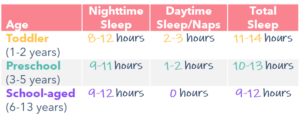How to Manage Problems at Bedtime
Bedtime resistance is very common—nearly 50% of parents have sleep-related concerns. This tutorial teaches two research-backed approaches to addressing bedtime resistance.
Goal

Overview
Did you know that up to 50% of all children in the United States have a least one sleep-related problem? The most common of these problems involves bedtime resistance, primarily in the form of crying or calling out from the bedroom.
The most common way to address bedtime resistance is the self-soothing approach—all calling out and crying is completely ignored once your child is in bed. The success of this method depends entirely on your absolute commitment to see it through. That means no contact of any kind while your child is crying. Going into the room while your child is still crying risks teaching him or her that crying “works” as a method for obtaining parental attention after bedtime. Ignoring it altogether teaches your child that crying is a useless method, and eventually they will give up and go to sleep.
The self-soothing approach can take several days to succeed and the crying will likely get worse and last longer in the beginning. So, despite its long track record of success, it can be challenging to stick with it. This program will explain how to use both the aforementioned self-soothing approach as well as an alternative approach: the parent-led soothing approach.
Important Note: This tutorial is intended for use with toddlers (about 18 months) and up.
Method

Establish a reasonable bedtime.
Under normal day-to-day circumstances, put your child to bed at their set bedtime every day.
Needed sleep (including naps) per day varies depending on the age of your child.
The American Academy of Pediatrics publishes guidelines on recommended sleep. You can use the chart below to determine how much sleep your child may need. When setting a bedtime, consider these sleep ranges. The easiest way to do this is to start with when you would like your child to wake up and work backwards to set bedtime.

Or try an alternative scientific method for learning the ideal amount of sleep.
For three straight days, let your child take naps and go to bed when they naturally feel tired and let them sleep until they wake naturally and easily. Add up all the hours of sleep obtained over the three days, divide by 3, and the result is your child’s ideal amount of sleep. (You could do this for yourself, too—the formula applies to people of all ages.)

Have quiet time before the bedtime routine.
About 30-60 minutes prior to bedtime, start “quiet time” during which your child should engage in quiet, relaxing activities. Avoid anything that would excite, anger, frustrate or activate them.
Examples of quiet activities include
- Putting toys “to bed” and saying good night to each
- Reading with or without you
- Saying prayers
- Saying good night to all the pets
- Slowly washing hands and face
- Brushing hair 100 times
Electronic devices should be put away. Although they can seem like a quiet activity, the light from and content in electronic devices interferes with sleep.

Start the bedtime routine.
Go through your regular bedtime routine. This can involve bath time, getting into pajamas, brushing teeth, a bedtime story, bathroom routine, kisses, etc. The routine should be predictable and as consistent as possible.

Have your child in bed at the established time.
Tell them goodnight and that you will see them in the morning (for the parent-led soothing approach, you can say you will see them shortly or in a few minutes).
Turn off the light, leave the room, and close the door (closing the door is optional). For children older than one, you can leave a soft toy and/or a blanket in the bed that they can use to comfort themselves when they’re learning to fall asleep alone (loveys, attachment objects, etc.).
Following a routine and saying goodnight
Mila and her dad use a visual schedule to go through the bedtime routine. A schedule or checklist can be really helpful to make it predictable. Notice how her dad says good night and immediately leaves the room.

Choose a soothing approach.
Once your child is in bed, this is where the soothing procedures starts. There are two soothing options: self-soothing or parent-led soothing. Click below to learn more about how to use these approaches.
Self-Soothing Approach
Parent-Led Soothing Approach
Challenges
I haven't noticed improvements within 1-2 weeks.
You should see less crying and earlier sleep times within about a week (self soothing) to two weeks (parent-led soothing). If you are not, review the plan. Are you following all the steps? If you are, stop and consult your child’s doctors.
It is too difficult to ignore my child’s cries using the self-soothing method.
Hearing your child cry is hard. Although it should only take a few nights to go away, there are other options. Consider switching to the parent-led soothing approach.
I am worried my child's cries will disturbs their siblings' sleep.
Crying should fade away in a few days. In the meantime, you can try the parent-led soothing approach, which usually has less crying. You can also try to move your other children further from the crying, start the procedure during a break (not a school night), or put your other children to bed first.
It was working, but then my child had a setback.
A sleep setback is when your child suddenly starts crying again at night. It is OK to check on them to make sure nothing is wrong. Once you are sure nothing is wrong, restart the program.
My child had a setback after being hospitalized or seriously ill.
Sleep setbacks are common during and following serious illnesses. Wait until after a follow-up visit with their doctor or until the home illness is over, and then begin the program again.
My child had a setback after sleeping in a new place.
Setbacks can also happen if your child is sleeping in a new place (e.g., grandparents house, on vacation, a new house). As soon as you are able, start the soothing program again.
Practice

Prepare
Identify the right bedtime. Create a bedtime routine. Find a good week or weekend to start.

Apply
Introduce the bedtime routine, and follow the soothing approach that works best for your family.

Repeat
Follow the bedtime routine and soothing recommendations every night for at least a week.
Next Steps
Continue with the plan!
Within a week, your child should be going to bed with little to no problem. Now just continue with the plan. If there are problems, refer to the challenges section or speak with your child’s doctor.
Delay your first check-in.
If you are using the parent-led soothing approach and things are going well, you can start to delay your first check-in. If you had been checking in after two minutes, have your first check in after five minutes.
